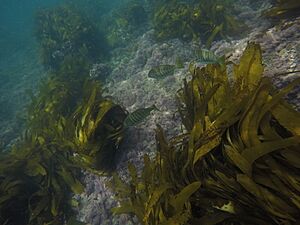Zebra-perch sea chub facts for kids
Quick facts for kids Zebra-perch sea chub |
|
|---|---|
 |
|
| Orange County, California | |
| Conservation status | |
| Scientific classification | |
| Synonyms | |
|
The zebra-perch sea chub (scientific name: Kyphosus azureus) is a cool fish that lives in the ocean. It's a type of "sea chub" and belongs to the Kyphosidae family. You can find it swimming along the coasts of North America in the eastern Pacific Ocean. People also call it the zebra perch or zebra sea chub.
What Does It Look Like?
The zebra-perch sea chub has a body that's a bit flat from side to side, like an oval. Its head is small with a pointy snout and a tiny mouth that has thick lips.
It has a long fin on its back called a dorsal fin. This fin has 11 stiff spines and 9 soft rays, which are like flexible bones. The spiny part is longer than the soft part. It can even fold this fin down into a groove on its back!
Its fin underneath, called the anal fin, has 3 spines and 10 soft rays. The soft rays on this fin are longer than those on its back fin. The tail fin, or caudal fin, is shaped like a fork. Its other fins, the pelvic and pectoral fins, are quite small.
The fish's body is covered in small, rough scales, except for its snout and the area between its eyes. Its main color is a pale khaki, but it has about 10 long, brown stripes going up and down its body, like a zebra! It also has a blue spot near the top of its gill cover and a black spot under its pectoral fin. Its belly is usually whitish. This fish can grow up to about 45 centimeters (18 inches) long.
Where Does It Live?
The zebra-perch sea chub lives in the eastern part of the Pacific Ocean. You can find it from Monterey Bay in California all the way down to Baja California and into the Gulf of California. It's most common in the northern and central parts of the Gulf of California.
Its Home and How It Lives
This fish likes shallow water close to the shore, usually in areas that are no deeper than 8 meters (about 26 feet). It lives around rocky reefs and flat reef areas where lots of algae grow. Adult fish live in the deeper parts of these areas, while young fish often hang out in rock pools.
The zebra-perch sea chub is a herbivore, which means it only eats plants. Its favorite foods are red, brown, and green algae.
Young zebra-perch sea chubs sometimes act like "cleaner fish." This means they help other fish by eating tiny parasites off their bodies. They do this for fish like the opaleye (Girella nigricans) and the shiner perch (Cymatogaster aggregata).
These fish often swim together in mixed groups with other species, like the halfmoon (Medianluna californiensis), opaleye, and Pacific sergeant major (Abudefduf troschelii). During the day, they are active, but at night, they hide in cracks and crevices in the rocks to sleep. They reproduce by releasing their eggs and sperm into the open water, which is called "pelagic spawning."
How It Got Its Name
The zebra-perch sea chub was first officially described in 1889 by two scientists, Oliver Peebles Jenkins and Barton Warren Evermann. They first named it Hermosilla azurea. They found the first example of this fish in Guaymas, Sonora, which is in western Mexico. Later, in 2013, scientists studied the family of fish it belongs to (Kyphosidae) and found that the name Hermosilla was actually the same as Kyphosus. So, its official scientific name became Kyphosus azureus.


